The Senate has closed debate on its bill. What have “moderates” wrought? Figures 1 and 2 depict the fiscal impulse arising from Senate and House bills, respectively.
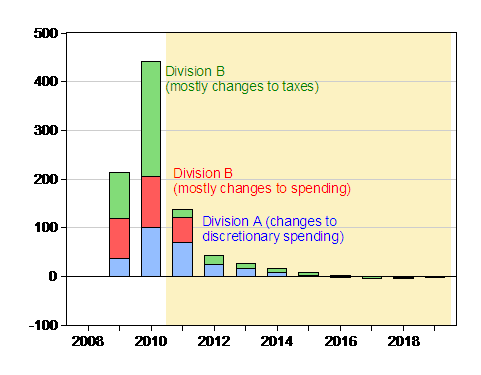
Figure 1: Estimated spending and tax revenue reductions, per fiscal year, embodied in HR 1 Senate version. Shaded areas pertain to spending occurring outside of the 20 month time frame. Source: CBO, Cost Estimate of amendments in the nature of a substitute by Senator Reid for Senators Nelson and Collins to HR 1 (February 9, 2009).

Figure 2: Estimated spending and tax revenue reductions, per fiscal year, embodied in HR 1 House version. Shaded areas pertain to spending occurring outside of the 20 month time frame. Source: CBO, Cost Estimate of HR 1 (January 27, 2009).
The vertical axes in Figures 1 and 2 have been made conformable. What is clear is that in the Senate compromise version, (1) the green portion (tax provisions, approximately) of the bars is bigger, and (2) a larger proportion of spending takes place in the next 20 months. Is that a good thing? In combination, no. What will happen is that there will be more tax cuts that expand the already increasing deficit but will have minimal impact on aggregate demand; and less spending on things that will have a maximal impact on aggregate demand. (By the way, throwing in big tax cuts that have minimal effect on aggregate demand makes it more likely that one gets fiscal policy ineffectiveness, as shown in Case 3 in this post.) Figure 3 shows the relative costs of each bill normalized by GDP.
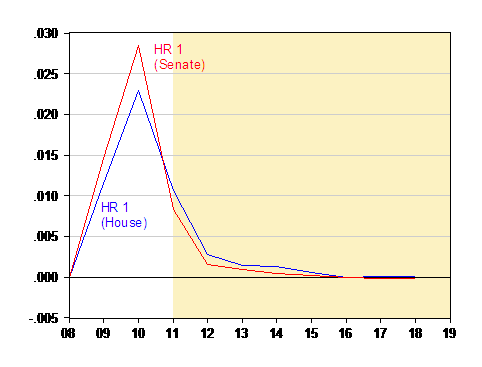
Figure 3: Estimated spending and tax revenue reductions, per fiscal year, divided by GDP. Shaded areas pertain to spending occurring outside of the 20 month time frame. Source: CBO, Cost Estimate of HR 1 (January 27, 2009), CBO, Cost Estimate of amendments in the nature of a substitute by Senator Reid for Senators Nelson and Collins to HR 1 (February 9, 2009), and CBO, The Budget and Economic Outlook: Fiscal Years 2009 to 2019, January 8, 2009.
I want to point out that I have been consistent in arguing for getting the maximal impact on aggregate demand per dollar stimulus. [1], [2] It is even more important because of the incredible profligacy of the Bush Administration which as I have repeatedly noted constrained our options should times like the ones we are now experience arrive. [3] [4] I would observe that those who argued “no problems” with borrowing driven by massive tax cuts, and borrowing from China, have little credibility. Readers of Econbrowser will know of whom I speak (there’s a pretty big overlap with those who are arguing against this stimulus package).
One observation is that it looks like the stimulus is more concentrated early on. But such an interpretation is misguided. Take a look at the components. The amounts in Div B “direct spending” provisions are very similar in the two bills. (Note: change of scale in axes.)
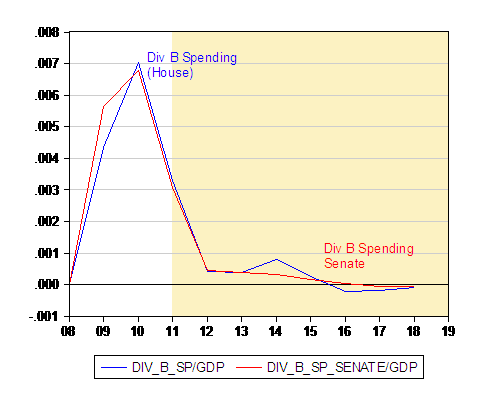
Figure 4: Cost of provisions in Division B spending, per fiscal year, embodied in HR 1 and HR 1 Senate version, divided by GDP. Shaded areas pertain to spending occurring outside of the 20 month time frame. Source: CBO, Cost Estimate of HR 1 (January 27, 2009), CBO, Cost Estimate of amendments in the nature of a substitute by Senator Reid for Senators Nelson and Collins to HR 1 (February 9, 2009), and CBO, The Budget and Economic Outlook: Fiscal Years 2009 to 2019, January 8, 2009.
The big differences come in terms of discretionary spending (Division A) and tax revenue provisions (Division B – revenues).
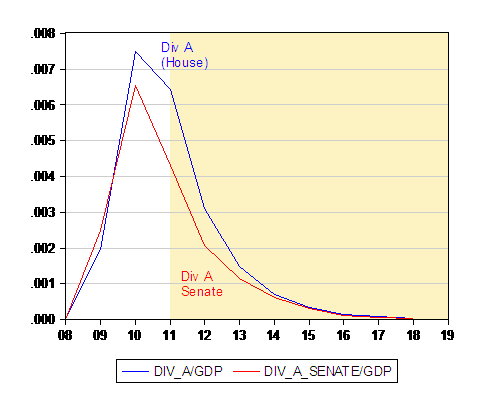
Figure 5: Cost of provisions in Division A spending, per fiscal year, embodied in HR 1 and HR 1 Senate version, divided by GDP. Shaded areas pertain to spending occurring outside of the 20 month time frame. Source: CBO, Cost Estimate of HR 1 (January 27, 2009), CBO, Cost Estimate of amendments in the nature of a substitute by Senator Reid for Senators Nelson and Collins to HR 1 (February 9, 2009), and CBO, The Budget and Economic Outlook: Fiscal Years 2009 to 2019, January 8, 2009.
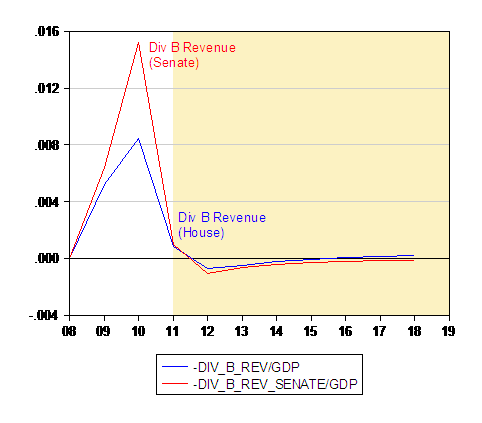
Figure 6: Cost of provisions in Division B revenues, per fiscal year, embodied in HR 1 and HR 1 Senate version, divided by GDP. Shaded areas pertain to spending occurring outside of the 20 month time frame. Source: CBO, Cost Estimate of HR 1 (January 27, 2009), CBO, Cost Estimate of amendments in the nature of a substitute by Senator Reid for Senators Nelson and Collins to HR 1 (February 9, 2009), and CBO, The Budget and Economic Outlook: Fiscal Years 2009 to 2019, January 8, 2009.
Most pernicious in the “compromise” was the stripping out of transfers to the state. For this, there is no reason in terms of stimulating aggregate demand to limit this component. The propensity to spend would have been the highest out of these funds. And the spending would have occured fairly quickly. Indeed, in so many of the cuts to the original Senate bill, the wrong things were cut. And the wrong things were expanded, including most importantly tax provisions. That expansion in tax provisions is seen in Figure 6.
The tragedy is that so many of these tax provisions are clearly going to have little “stimulus” effect (e.g. homebuyer credit [5] [6]). But where is the Republican outrage on this count?
So, summing up, I can’t see a reason to dissent with Krugman’s assessment of what the “moderates” have given us.
The original plan also included badly needed spending on school construction; $16 billion of that spending was cut. It included aid to the unemployed, especially help in maintaining health care — cut. Food stamps — cut. All in all, more than $80 billion was cut from the plan, with the great bulk of those cuts falling on precisely the measures that would do the most to reduce the depth and pain of this slump.
Just to remind people, here are the ranges of estimates for multipliers for various types of measures, as provided by the nonpartisan Congressional Budget Office.

Table 5: from The State of the Economy and Issues in Developing an Effective Policy Response,” testimony of CBO Director Douglas Elmendorf, January 27, 2009.
Just to remind us all of the stakes involved, take a look again at the vertical axis in Figure 3: it’s the ratio to GDP. This “massive” stimulus bill is pretty small relative to GDP. And in the absence of a cost-effective stimulus bill, we are hurtling toward a negative output gap that — in the post-War era — is of unparallelled proportions, in terms of depth and duration.
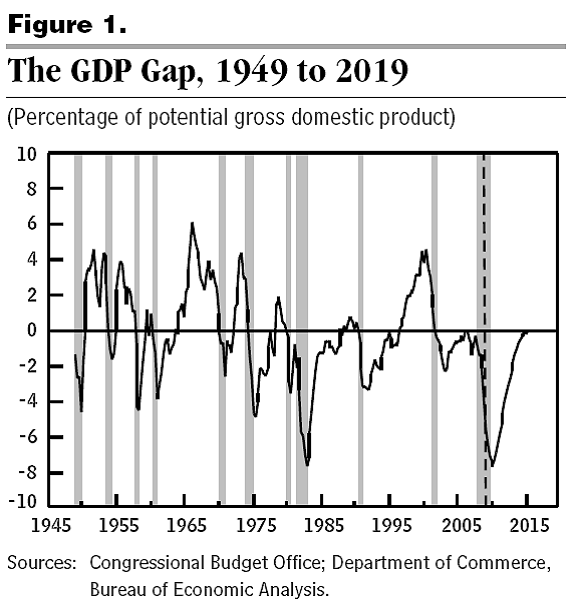
Source: CBO, The Economic Outlook, 7 January 2008.
Given what data has come out since January 7, I have no reason to believe the outlook is any better than what is provided in this picture.
While this has been a depressing weekend for those of us who believe that reason can triumph over sheer ignorance, at least it’s provided plenty of examples of bad reasoning to dissect in macro class. (By the way, still looking for a reputable macroeconomist against a stimulus bill [7].)
Technorati Tags: stimulus bill, recession,
tax cuts, fiscal profligacy, GDP.
Take some solace from the fact that the 09 deficit will be more than double the size of the ‘stimulus’. That ought to be Keynesian enough for you. Even tho’ it isn’t apportioned as you like, when the total deficit for ’09 & ’10 amounts to $5 trillion & the economy still stinks, will you admit then that Keynesianism is misguided?
It is intriguing that as an oberver of history you expected the politicians to behave reasonably or intelligently rather than politically.
Menzie writes “By the way, still looking for a reputable macroeconomist against a stimulus bill.”
How about James Hamilton? Over the weekend, he wrote on this blog “But rushing through new government spending plans, just for the sake of spending? Count me off of that bandwagon”
OK. He endorses some help for state budgets and infrastructure spending on positive NPV projects. But he sounds like a real macroeconomist against a stimulus bill to me.
Fred: Here was my immediate proposal, and other ideas I support are briefly outlined here and here.
Professor,
Even assuming that Keynesianism on paper is “correct,” will you at least concede that, in a world where not all government spending is created equal, and politicians and bureaucrats act in their self-interest, that government spending-driven stimulus may lead to sub-optimal outcomes and unintended consequences? I’ve taken a class with you and I agree with you on many topics, but I’m disheartened by your zealousness for Keynesianism in this regard.
Fred: A stimulus bill is one which injects spending into the economy. My reading is that Jim is in favor of one, but is in favor of one that is structured to maximize the bang for the buck, and is timely, targeted and temporary. And as you point out, he and I and the Democrats are in favor of transfers to the states. So I don’t know where you’re coming from.
Menzie,
I would be curious to see how the actual stimulus packages before congress stack up against proposals of individual economist’s, like JDH, Greg Mankiw, and others like Brad DeLong and Paul Krugman, if they’ve specified them. If they haven’t made their personal proposals public, maybe they’d offer them if you asked?
That’s a lot of free candy I’m requesting. Obviously you should only do this if you also think it would be interesting and you think other readers would appreciate it.
Great work, as always…
Although the Republicans are demonstrating their profound ignorance — 90% of GOP senators and 95% of GOP congressmen voted for an alternate plan that had all tax cuts and no spending — you have to admit that their job has been made easier by distinguished members of your profession such as Lucas, Fama, Cochrane, Barro, Mankiw, Becker, and Prescott who have provided political cover for the do-nothing and tax-cuts crowd. It seems that economics has progressed little from the disagreements of Hayek and Keynes 70 years ago. Can we really blame the politicians for being confused?
Menzie and JDH,
I guess I interpreted “a stimulus bill” as “the stimulus bill” currently being debated in DC. I’ll read more carefully next time.
The loudest voices in the econ blogosphere seem to view the current package as better than nothing and to view more spending as better than less. Your specific proposals stand in stark contrast.
This blog is a breath of clarity and common sense among the pettiness. Keep it up.
I find it interesting that many of the most popular “economics” blogs openly wear their partisanship on their sleeves, even when it means not-infrequent contradictions of past commentary.
It’s similar interesting to note that while none of these blogs saw the scope and nature of the present meltdown coming, they are all strongly certain in their belief that they are now (at least personally) locked on to the best and only good path to repair.
It seems as if POTUS has to resort to lying: emphasis mine
“As I said, the one concern I’ve got on the stimulus package, in terms of the debate and listening to some of what’s been said in Congress, is that there seems to be a set of folks who — I don’t doubt their sincerity — who just believe that we should do nothing.”
From HR1 courtesy of Drudge:
“The bill’s health rules will affect ‘every individual in the United States’ (pg #’s PDF: 445, 454, 479). Your medical treatments will be tracked electronically by a federal system. Having electronic medical records at your fingertips, easily transferred to a hospital, is beneficial. It will help avoid duplicate tests and errors.”
I believe Russ Roberts hits the nail on the head:
http://www.cafehayek.com/hayek/2009/02/creepy.html
Menzie: Would it be easy to make a chart which is essentially an inner product of your current charts with the table of multipliers? Right now the height of the pieces of the bars is determined by the amount spent or foregone, rather than by its anticipated effect? (I.e. dynamic multipliers rather than raw shocks)
I am particularly concerned that some of the eliminations owing to the “centrists” seem, as you say to be on high multiplier items.
RE Paul Krugman: “It included aid to the unemployed, especially help in maintaining health care — cut.” Since when was the healthcare industry in need of stimulation? Last I checked there were no doctors down at the unemployment office. Might be a good thing to do, but it has little or nothing to do with jump starting the economy.
This is the problem. I agree that both parties do it (not just the bad old republicans, but exalted democrats as well), but don’t call pet spending projects economic stimulus.
Can someone resolve this paradox for me?
The permanent income hypthesis says that transitory, short-term changes in income have little effect on consumer spending behavior. The first attempt at economic stimulus last year was a transitory cash payment from the government to households. As predicted by the permanent income hypothesis, the stimulus failed to stimulate in a meaningful way.
How is the current stimulus package different? There are lots of temporary tax cuts and temporary spending increases. Will consumers feel that their expected income has risen?
It seems the result will be a two year blip, then back to where we are today, but with a defecit that is over a trillion dollars larger.
To further complicate matters, if policy makers decide to make large portions of tax cuts and spending permanent, then we have a permanent increase in the deficit and a drag on future growth.
It seems like a more reasoned approach would be to take a few weeks to identify a few key permanent changes to taxes and spending that will create permanent changes to expected income. Vote on 1 piece at time if necessary.
That’s probably asking too much of Congress.
The current bill is much more than a stimulus bill. It is a payoff bill for the folks who helped get Obama and the Democrats elected. Unfortunately, the middle class of the country is once again taking it in the shorts. It seems with the Republicans it was giving huge amounts to the oil companies, banks and billionaires. This was done thru lower taxes and corporate welfare, such as farm subsidies for corporate farms and the continued oil depletion allowances for Exxon et al. If you add in the military industrial complex, we find ourselves with a huge deficit.
Now the Dems are giving away the farm through a multitude of expansions in so called entitlements and pet experiments on the core of the poor population. Meanwhile the middle class, which lost half its savings, half the value in their homes and had their credit card interest raised and their lines of credit reduced or closed have not been allowed even the campaign promise of no taxes on their 2008-2009 unemployment and IRA’s that they are cashing out to survive.
It is time to eliminate the income tax, cut federal spending by 20% and allow that capital to flow to the people who earn it.
The middle class as defined by those making between $45,000 and $250,000 per year, do in fact pay the majority of taxes. They are currently being whipsawed every 4 to 8 years by both parties.
We are getting sick of the shakedown and out-right illegal plundering of the nations wealth.
Perhaps it is time for a real march on Washington!! Maybe a summer campout in Obama’s front yard until somebody gets it!!!
This stimulus will put more pressure on the middle class as inflation rears it’s ugly head in two years. Menzie, I want you to save this post for 2011-12, when we are paying $12.50 for a loaf of bread and then remember what Keynesian economics has done to the Middle Class.
Addendum – If the package is meant to be a bridge to better times and we are going to ignore permanent income changes, then why not make it simple?
Give the bottom 50 million households $1,000 per month for 20 months. That’s a trillion dollars if my math is correct and these lower income households may be forced to spend rather than save.
Just wait until the 7 and 10 year ARMs are due on theses overpriced homes all hell is going to break loose…
The use of the stimulus bill for ‘extra-curricular’ activities like healthcare reform is a highly risky endeavor. What it suggests is that the Administration is really not serious about the recession, and that the package is just a devious way to implement Democratic priorities.
AJB: Yes, sure. See here. Glad to see you are still interested in economics after taking my class. What you take as zealous Keynesianism is what I take as the reasonable approach given an incipient output gap that is as big as shown in Figure 1 from the CBO report. And my experience with forecasters and organizations is that they do not tend to err on the pessimistic side…In any case, think about the other alternative models I taught in class, and what they tell you about the magnitude of effects and length of time necessary for those other effects to play out, and then come back with an alternative plan. Think of that as Extra Credit Problem Set “N”. I look forward to seeing your thoughts on this blog.
Joseph: Maybe you’re right. It’d be interesting to see a histogram of views of PhD economists that work in JEL codes in macro, monetary, international finance, although how to summarize quantitatively the views on stimulus would be a challenge. But I do think that many of the senators do know better — but they cloak their ideological beliefs in the guise of believing that tax cuts have bigger multipliers.
MM: I am impressed that you have surveyed all economics blogs and find all of them failed to see the size and scope of this calamity we are now only beginning to experience.
Babinich: I fail to see the falsehood in the bold-faced section of your quote. There must be at least one representative and/or senator that thinks the government should get out of the way (Ron Paul, perhaps).
tj: Recall the PIH in the Hall interpretation would indicate that consumption would only equal the annuity value of the tax cut; the empirical testing of this relation relied upon estimation of the Euler condition for the consumer’s problem, assuming away a liquidity constraints, and assuming unbiased expectations. Campbell and Mankiw, in a couple papers, documented the empirical shortcomings of this approach (including implausibly high IRS, etc.); they modified the PIH-LC theory with the incorporation of rule-of-thumb consumers. Others have tried to model explicitly liquidity constrained households, or to allow for non-certainty equivalence risk aversion. When one does this, then one does not necessarily obtain the standard implication regarding the minimal impact of a tax cut.
So, I’ll ask it again: the Bush administration was an awesome experiment in macroeconomics. He did it all: cuts in marginal tax rates, temporary demand side tax cuts, and massive increased in spending, both domestic and on the military.
So this was a failure, but the answer is to do more of it? Just a lot more?
The increase in the deficit under Bush averaged about ~$600B a year. Obama is going to blow past that in his first month in office.
Buzzcut: So I’ll say it again. The difference is not to dump all the tax cuts into the laps of the top income decile, and not so much of a ten year tax cut. And not to spend so much on defense, especially abroad where the spending leakage is greater. Bush averaged $600 billion deficit per year at or near full employment for most of the time, and took us from 1 to 1.5 ppt of GDP structural budget surplus to a 2 to 2.5 ppt of GDP structural budget deficit.
Here’s an idea…
Any burglar who has spent his loot on consumption, and can show that the source of his loot was not planning to spend it, will have the burglary charge dropped and instead be commended for stimulating the economy.
Not my own idea, but a funny one. (from here).
The Cato Institute ran full page ads in the New York Times, Washington Post and Wall Street Journal last week that stated:
“Notwithstanding reports that all economists are now Keynesians and that we all support a big increase in the burden of government, we the undersigned do not believe that more government spending is a way to improve economic performance. More government spending by Hoover and Roosevelt did not pull the United States economy out of the Great Depression in the 1930s. More government spending did not solve Japan’s “lost decade” in the 1990s. As such, it is a triumph of hope over experience to believe that more government spending will help the U.S. today. To improve the economy, policymakers should focus on reforms that remove impediments to work, saving, investment and production. Lower tax rates and a reduction in the burden of government are the best ways of using fiscal policy to boost growth.”
This was signed by 200 economists with a few Nobel’s thrown in (James Buchanan, Edward Prescott, Vernon Smith).
Their prescription is more tax cuts and less spending, the exact opposite of Menzie Chinn’s. They don’t even agree that government spending works in depressions (although they don’t explain what was different about the 40’s.)
It seems that economists are still undecided on issues as fundamental as whether the earth is round or flat. To the non-economist it is hard to tell if this is a minority view or mainstream. It is not surprising that citizens and politicians are confused. How are they to judge?
Menzie, that’s simplistic. The tax cuts were multifaceted. He cut EVERY marginal tax rate, including the 15% bracket going to 10. He jacked up the child tax credit as well. And he sent out rebate checks… twice.
On spending, the Iraq war was but one area of spending. We had simply massive increases in domestic spending. No Child Left behind is but one example.
So… Your explanations don’t jibe with reality. Bush did it all. And it didn’t keep the economy rolling. So why is this so called stimulus any better?
And keep in mind that the ’01 and ’03 tax cuts were not done in a full employment environment. Not even close.
BTW, is Arnold Kling not a macroeconomist? His posts on rethinking macroeconomics are very, very good.
Is Alice Rivlin not a macroeconomist?
In testimony before the House Budget Committee yesterday, Alice M. Rivlin, who was President Bill Clinton’s budget director, suggested splitting the plan, implementing its immediate stimulus components now and taking more time to plan the longer-term transformative spending to make sure it is done right.
“Such a long-term investment program should not be put together hastily and lumped in with the anti-recession package. The elements of the investment program must be carefully planned and will not create many jobs right away,” said Rivlin, a fellow at the Brookings Institution. The risk, she said, is that “money will be wasted because the investment elements were not carefully crafted.”
Menzie, in your response to Buzzcut above, recall that in 2003-2004, there was a lot of talk about a “jobless recovery” when the unemployment rate ranged between 5-6%. This may have even led Greenspan to keep the Fed Funds rate too low. But as you point out, the truth is that 5-6% unemployment is probably full employment. The late 1990’s when unemployment got below 4% was unsustainable. So high government spending in that period probably caused more crowding out than stimulus. So I agree with you on that point.
But I disagree about the tax cuts. You said “The difference is not to dump all the tax cuts into the laps of the top income decile…” On a percentage basis, the marginal tax rates for low income earners dropped the most, going from 15% to 10%. From an incentive standpoint, weren’t the low income earnings given the biggest change in incentives?
Menzie_Chinn: You’re “still looking for a reputable macroeconomist against a stimulus bill”?
Why aren’t you looking for a macroeconomist FOR a stimulus bill who saw this crisis coming and for the right reason, and not because they predict a crisis every year?
Do correct predictions matter to you?
MikeR: You’re talking about incentives and margins, which I agree are important especially in the long run. I’m talking about liquidity constraints an income side effects. Glad we agree on the crowding out point — see case 3 in the “Five reasons…” post.
Buzzcut: 2003 was not near full employment? Hmmm. OK, to heck with CBO Figure 1 in the post!
Alice Rivlin did not argue against a stimulus bill; she critiqued this particular bill (I have high regard for Dr. Rivlin — I used to work for her. Somehow, I don’t think you’ll be quoting her in other regards where she has argued for countercyclical policy). As for Kling (at least the posts I’ve read), he’s for a small stimulus — but if I read it correctly, if a large one could be implemented efficiently, he’d be for it. Of course, I think he’s got substantial wiggle room since — to my knowledge — he hasn’t specified exactly how big is small. I am, however, happy to be corrected with specific numbers.
Menzie, you’re arguing against a strawman. We’re all for a stimulus of some sort, including targeted spending. We’re all arguing against THIS stimulus!
Kling wants a payroll tax holiday. So is that not a stimulus?
You’re the only person arguing for THIS stimulus. Or worse, you’re arguing for the uber-pork Pelsoi-House stimulus.
Joseph: You’re citing a Cato ad? Well, consider Buchanan won for public choice theory, Smith for experimental economics. Ed Prescott won for time inconsistency and real business cycle theory. Indisputably important work, relevant to macro and growth. Does RBC theory fit your Weltanschauung? If not, I’d think twice about citing. So think about the lists you’re citing, don’t just count numbers (and by the way, there are thousands of PhD economists in the country).
Menzie,
The Ambrosini Critique has complied a list of macroeconomists, a number of whom are against the stimulus. Willem Buiter, formerly of the UK’s MPC questions the ability of the US to afford such a stimulus. More from Buiter on why he does not think the US or UK should pursue a large fiscal expansion. In short I don’t think you have been looking very hard, if you haven’t found respected macroeconomists opposing the stimulus.
Note that Krugman is not a macroeconomist. I don’t know why people are giving him such props in this stimulus debate. Personally I think he likes other aspects of the stimulus bill that are not stimuli for the economy, but serve his political ends.
Note further that Taylor, listed on Ambrosini’s chart as favoring the stimulus, favors tax cuts as the primary mechanism.
Sorry wrong link to my first Buiter reference. Here is Buiter questioning the ability of the US to afford a large fiscal expansion.
Dan in Euroland: Thanks for th epost – very interesting. But I didn’t specify what sort of stimulus bill. Some people support a bill that is entirely composed of tax cuts. That’s a stimulus bill — in my opinion, likely to be an incredibly ineffective one, but still a stimulus bill. But I take your point that Tom Sargent is against (Acemoglu doesn’t seem against, by the way). By the way, Delong is not a macroeconomist, but Acemoglu is?
Kling just put up a post that more or less responds to your “no macroeconomist” argument.
The comments there are really, really good, too.
“By the way, still looking for a reputable macroeconomist against a stimulus bill”
I gather that Taylor, Lucas, Sargent, Barro, and others generally disagree with a fiscal stimulus approach. Taylor’s presentation at AEA last month seemed rather blunt on the subject.
http://www.stanford.edu/~johntayl/AEA_Paper_on_Fiscal_Policy_2009_JBT.pdf
Don’t they count?
Menzie wrote:
By the way, still looking for a reputable macroeconomist against a stimulus bill
Then in response to Joseph:
I’d think twice about citing. So think about the lists you’re citing, don’t just count numbers (and by the way, there are thousands of PhD economists in the country
The flat world society does not accept any criticism from those outside the society.
Those who defend pre-18th Century mercantilism do much the same. If you do not follow mercantilist analysis your analysis is not valide so don’t quote from those who disagree.
You can win any argument if you define the terms.
“Can someone resolve this paradox for me?
The permanent income hypothesis says that transitory, short-term changes in income have little effect on consumer spending behavior. The first attempt at economic stimulus last year was a transitory cash payment from the government to households. As predicted by the permanent income hypothesis, the stimulus failed to stimulate in a meaningful way.”
Yes. The fundamental problem is that the world economy has suffered a massive and surprising shock to the system. This massive shock has frightened consumers into cutting consumption on a massive scale. In economic terms they?ve increased their savings. While the increase in savings is a long term plus for the economy, the fact that the shift happened so fast has caused a crash in consumption which has created skyrocketing unemployment. This is referred to as the Paradox of Thrift. If too many people all of a sudden withdrawal their consumption from the economy (increase savings) you can create a situation where skyrocketing unemployment further destroys demand as consumption is further curtained because people without (or with less) incomes can?t spend at a rate high enough to sustain current employment. You end up with a vicious cycle that creates more unemployment and less consumption and no savings.
The problem with temporary tax cuts is that too much of it gets saved and not spent. And with so much fear of jobs loss swirling around the economy most of the tax cut gets saved incase people get laid-off. In the Keynesian world the solution to breaking the cycle created by the paradox of thrift isn?t giving people ?some money to spend?, but in breaking the fear of unemployment and giving them income by employing them. A Keynesian stimulus is not intended to be permanent, its intended to keep workers employed long enough for the economy to adjust and for people to become secure enough to spend again.
The auto industry is a perfect example (and I don?t just mean Detroit). Right now demand has fallen so far it implies people will keep their cars on average for over 20 years. Even the best build cars are not on average going to last that long. This is not a sustainable drop in consumption. However, it could become reality if the downward cycle goes unchecked. If you can break the cycle by increasing incomes (lowering unemployment) eventually people will start buying cars again.
Too many economists forget that their models only represent human behavior. Right now we are looking for a method to break the cycle of savings that is driven by fear. That said a massive Keynesian stimulus doesn?t fix the economy as a whole. It only buys us time to fix the financial system and break the immediate downward spiral.
The words of another macroeconomist: the legendary Ray Fair:
I’d put this in the column of “against the bailout”…
Regarding the search for a single reputable macroeconomist… Barro isn’t a reputable macro guy?
As to the Cato list of 200 economists, saying that all those who aren’t Nobelists aren’t reputable, and those who are Nobelists aren’t macro guys, so all their opinions are all disqualified … well, that’s setting a high hurdle to eliminate all reputable dissenting opinion. Though it equally eliminates 99% of agreeing opinion among all those thousands of other economists: Krugman’s not a macro guy, DeLong doesn’t have a Nobel, etc.
Specifying “a” stimulus isn’t very helpful either — living in the real world, the meaningful question is whether to support the actual stimulus package we’ve been presented with by the political process. “99% of macroeconomists can imagine some sort of stimulus they’d support, therefore this bill deserves support” is not logical.
It’s sort of like choosing a politician for elected office. We can all imagine a great leader we’d happily entrust ourselves to … but when we see whom we actually have to choose from, it can drive sound-thinking people towards libertarianism.
Personally, I surely could support “a” stimulus, maybe even this one — but also feel that pushing an argument to “… and no reputable informed person in the entire world could disagree with me” is always a bad idea and invitation to error.
Jim Glass: Yes, Barro is reputable. Although I have been a little careful about his commentary about current events ever since this (non peer reviewed) article, wherein me missed a data break indicator, and completely misinterpreted the data.
I have created a solution to many if not all the componet parts of the current financial crisis.To view solution in it’s detail see american copyright#TXu000496588. Upon review, if interested in Applications,Licensing and consulting considerations please contact me at gbaldy@cox.net.
Best Regards,
Jerry baldy
Professor Menzie Chinn,
I have recently debated that tax cuts have not maintained GDP growth and have greatly increased the deficit. I don’t need help to argue these points, but I do need a clearer definition and background as to the merits of CBO and Z graphs on line. Would you have time to look at these and at a minimum state their merits?
http://www.cbo.gov/
Total Deficit or Surplus (Percentage of gross domestic product)
http://zfacts.com/p/318.html
National Debt Graph: Bush Sets 50-Year Record